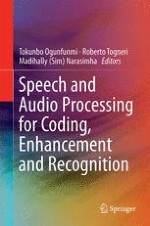2015 | OriginalPaper | Buchkapitel
9. Maximum A Posteriori Spectral Estimation with Source Log-Spectral Priors for Multichannel Speech Enhancement
verfasst von : Yasuaki Iwata, Tomohiro Nakatani, Takuya Yoshioka, Masakiyo Fujimoto, Hirofumi Saito
Erschienen in: Speech and Audio Processing for Coding, Enhancement and Recognition
Verlag: Springer New York
Aktivieren Sie unsere intelligente Suche, um passende Fachinhalte oder Patente zu finden.
Wählen Sie Textabschnitte aus um mit Künstlicher Intelligenz passenden Patente zu finden. powered by
Markieren Sie Textabschnitte, um KI-gestützt weitere passende Inhalte zu finden. powered by
